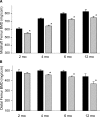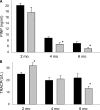Impact of pregnancy-associated plasma protein-a deletion on the adult murine skeleton
- PMID: 18086007
- PMCID: PMC2674540
- DOI: 10.1359/jbmr.071210
Impact of pregnancy-associated plasma protein-a deletion on the adult murine skeleton
Abstract
Introduction: The metalloproteinase, pregnancy-associated plasma protein-A (PAPP-A) functions to enhance local insulin-like growth factor (IGF)-I bioavailability through cleavage of inhibitory IGF binding proteins. Because IGF-I is an important regulator of skeletal growth and remodeling and PAPP-A is highly expressed by osteoblastic cells, we hypothesized that, in the absence of PAPP-A, bone physiology would be compromised because of a blunting of local IGF-I action even in the presence of normal circulating IGF-I levels.
Materials and methods: pQCT, muCT, histomorphometry, and mechanical strength testing were performed on bones from PAPP-A knockout (KO) mice and wildtype (WT) littermates at 2-12 mo of age. IGF-I levels and bone formation and resorption markers were determined in sera from these animals.
Results: Volumetric BMD in PAPP-A KO mice measured by pQCT at the femoral midshaft, which is primarily cortical bone, was 10% less than WT at 2 mo. This difference was maintained at 4, 6, and 12 mo. Cortical thickness at this site was similarly decreased. On the other hand, trabecular bone at the distal femur (pQCT) and in the tibia (muCT) showed age-progressive decreases in bone volume fraction in PAPP-A KO compared with WT mice. Tibial muCT indicated a 46% relative decrease in trabecular bone volume/total volume (BV/TV) and a 28% relative decrease in trabecular thickness in PAPP-A KO compared with WT mice at 6 mo. These trabecular deficiencies in PAPP-A KO mice corresponded to a weakening of the bone. Serum markers and bone histomorphometry indicated that the primary impact of PAPP-A is on skeletal remodeling resulting in a state of low-turnover osteopenia in adult PAPP-A KO mice. Circulating IGF-I levels were not altered in PAPP-A KO mice.
Conclusions: PAPP-A is a bone growth regulatory factor in vivo and, in its absence, mice show skeletal insufficiency in mass, density, architecture, and strength. The data suggest a primary role for PAPP-A in modulating local IGF bioavailability for trabecular bone remodeling.
Figures



Similar articles
-
Pregnancy-associated plasma protein-A modulates the anabolic effects of parathyroid hormone in mouse bone.Bone. 2015 Dec;81:413-416. doi: 10.1016/j.bone.2015.08.015. Epub 2015 Aug 20. Bone. 2015. PMID: 26297833 Free PMC article.
-
Insulin-like growth factor (IGF)-I and IGF-II contribute differentially to the phenotype of pregnancy associated plasma protein-A knock-out mice.Growth Horm IGF Res. 2011 Oct;21(5):243-7. doi: 10.1016/j.ghir.2011.06.002. Epub 2011 Jul 28. Growth Horm IGF Res. 2011. PMID: 21802327 Free PMC article.
-
Targeted deletion of the sclerostin gene in mice results in increased bone formation and bone strength.J Bone Miner Res. 2008 Jun;23(6):860-9. doi: 10.1359/jbmr.080216. J Bone Miner Res. 2008. PMID: 18269310
-
Osteopenia and impaired fracture healing in aged EP4 receptor knockout mice.Bone. 2005 Jul;37(1):46-54. doi: 10.1016/j.bone.2005.03.016. Bone. 2005. PMID: 15869929
-
The skeleton in primary hyperparathyroidism: a review focusing on bone remodeling, structure, mass, and fracture.APMIS Suppl. 2001;(102):1-52. APMIS Suppl. 2001. PMID: 11419022 Review.
Cited by
-
Skeletal disorders associated with the growth hormone-insulin-like growth factor 1 axis.Nat Rev Endocrinol. 2022 Jun;18(6):353-365. doi: 10.1038/s41574-022-00649-8. Epub 2022 Mar 14. Nat Rev Endocrinol. 2022. PMID: 35288658 Review.
-
Role of IGF1 and EFN-EPH signaling in skeletal metabolism.J Mol Endocrinol. 2018 Jul;61(1):T87-T102. doi: 10.1530/JME-17-0284. Epub 2018 Mar 26. J Mol Endocrinol. 2018. PMID: 29581239 Free PMC article. Review.
-
Recombinant IGF-1 Induces Sex-Specific Changes in Bone Composition and Remodeling in Adult Mice with Pappa2 Deficiency.Int J Mol Sci. 2021 Apr 14;22(8):4048. doi: 10.3390/ijms22084048. Int J Mol Sci. 2021. PMID: 33919940 Free PMC article.
-
Growth hormone, insulin-like growth factors, and the skeleton.Endocr Rev. 2008 Aug;29(5):535-59. doi: 10.1210/er.2007-0036. Epub 2008 Apr 24. Endocr Rev. 2008. PMID: 18436706 Free PMC article. Review.
-
In vivo analysis of gene expression in long-lived mice lacking the pregnancy-associated plasma protein A (PappA) gene.Exp Gerontol. 2010 May;45(5):366-74. doi: 10.1016/j.exger.2010.02.009. Epub 2010 Mar 1. Exp Gerontol. 2010. PMID: 20197085 Free PMC article.
References
-
- Rosen CJ. Insulin-like growth factor I and bone mineral density: Experience from animal models and human observational studies. C. lin Endocrinol Metab. 2004;18:423–435. - PubMed
-
- Conover CA. Insulin-like growth factors and the skeleton. In: Canalis E, editor. Skeletal Growth Factors. Philadelphia, PA, USA: Lippincott Williams & Wilkins; 2000. pp. 101–116.
-
- Clemens TL, Chernausek SD. Genetic strategies for elucidating insulin-like growth factor action in bone. Growth Horm IGF Res. 2004;14:195–199. - PubMed
-
- Lupu F, Terwilliger JD, Lee K, Segre GV, Efstratiadis A. Roles of growth hormone and insulin-like growth factor 1 in mouse postnatal growth. Dev Biol. 2001;229:141–162. - PubMed
-
- Bikle D, Majumdar S, Laib A, Powell-Braxton L, Rosen C, Beamer W, Nauman E, Leary C, Halloran B. The skeletal structure of insulin-like growth factor I-deficient mice. J Bone Miner Res. 2001;16:2320–2329. - PubMed
Publication types
MeSH terms
Substances
Grants and funding
LinkOut - more resources
Full Text Sources
Molecular Biology Databases
Research Materials
Miscellaneous

